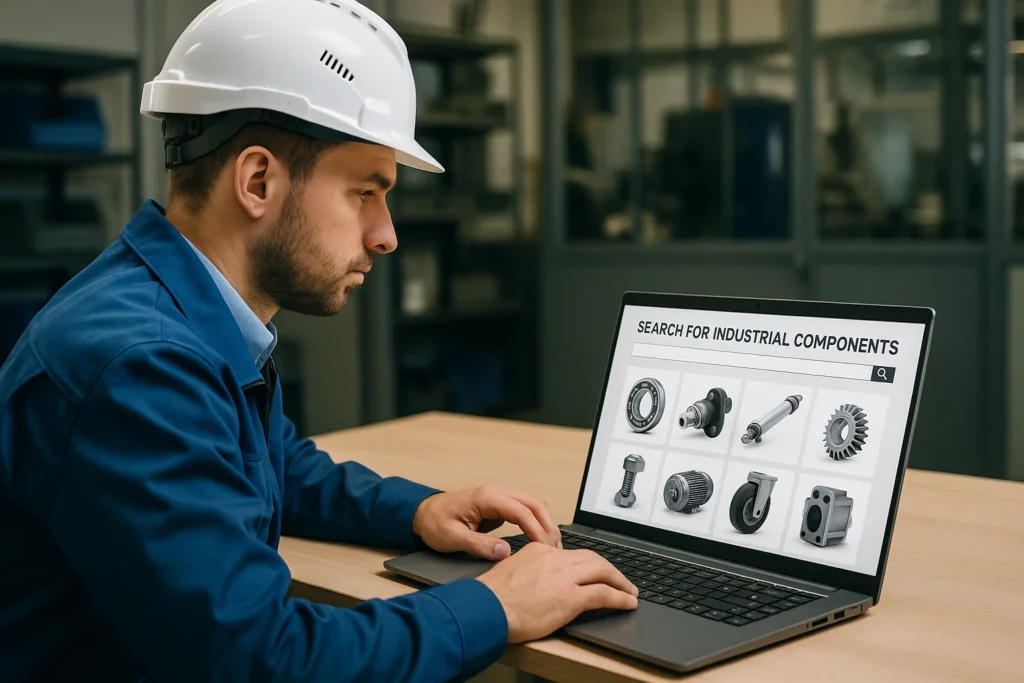Home » Guide To Manufacturer SEO
I’ll be honest with you right from the start – manufacturing SEO might not sound like the most exciting topic in digital marketing. But after years spent working with industrial businesses, I’ve found it’s actually one of the most rewarding sectors for SEO work.
You see, manufacturing companies have something most businesses don’t – genuine technical expertise and truly unique products. This creates amazing opportunities for content that stands out and attracts exactly the right audience.
From my personal experience, I’ve found working with manufacturers genuinely enjoyable. There’s something satisfying about diving into the technical details of industrial products and figuring out how to present them to both search engines and potential customers in a way that drives real business.

Most manufacturing companies I’ve spoken with initially relied on trade shows, print catalogues and personal relationships to generate business. Many still do. But the buying process has fundamentally changed. Today’s engineers, specifiers and procurement teams start their search online, and if you’re not visible there, you’re missing opportunities.
What makes manufacturing SEO different is the level of technical detail involved. Unlike consumer products that can be marketed with lifestyle imagery and emotional appeals, industrial products involve complex specifications, compliance standards and technical applications. This creates unique challenges but also significant opportunities.
This guide shares what I’ve learned working with UK manufacturers across engineering, fabrication, industrial equipment and specialist production sectors. I’m focusing on practical approaches rather than theory – things that actually work in the real world of industrial marketing.
The first thing to understand about manufacturing SEO is that your buyers have a completely different search behaviour than consumers.
Manufacturing customers don’t just hop online, search once and make a purchase. The buying cycle is long and complex, often involving multiple stakeholders with different priorities:
Each of these people searches differently and needs different information. Your SEO strategy needs to account for all of them.
I recently chatted with a procurement manager at a large manufacturing firm who told me something revealing: “I might not know exactly what model number we need, but I know the problem we’re trying to solve. So that’s what I search for first.”
This is a crucial insight. Many manufacturers focus solely on product specifications in their content, missing the problem-based searches that often happen earlier in the buying cycle.
Based on my work with industrial companies, I’ve observed that manufacturing searches typically fall into three broad categories:
These happen when someone recognises an issue but hasn’t decided on a solution approach:
This is where engineers and technical managers often start their journey.
Once they’ve identified potential solution approaches, searches become more focused on evaluation:
At this stage, they’re evaluating different technologies or methodologies, not yet specific suppliers.
These happen when they’re ready to evaluate specific products or companies:
This is when they’re directly comparing potential suppliers and products.
Understanding these stages is crucial because most manufacturing companies focus exclusively on the third stage – product and supplier searches. But by this point, buyers have already formed strong opinions about what solution they need. If you want to influence their decision, you need content targeting those earlier searches too.
Before diving into content strategy, we need to talk about the technical foundations. Manufacturing websites often have unique technical challenges that general SEO advice doesn’t address.
Many manufacturing websites I’ve worked with have hundreds or thousands of products, each with their own specifications, applications and variations. This creates several technical challenges:
Each product needs its own dedicated page with a unique, descriptive URL. A logical structure might look like:
yourwebsite.co.uk/product-category/sub-category/specific-product
For example:
yourwebsite.co.uk/sensors/temperature/high-temperature-thermocouple-type-k
This hierarchy helps both search engines and users understand the relationship between products.
A common issue I see is creating separate pages for minor product variations, leading to duplicate content problems. Instead, consider:
How you present technical specifications matters enormously for both SEO and user experience:
I’ve seen manufacturing websites transform their organic traffic simply by restructuring how they present technical specifications. It’s not just about having the data – it’s about making it accessible to both users and search engines.
Schema markup (structured data) is particularly valuable for manufacturing websites. It helps search engines understand the specific details of your products.
For manufacturing products, the basic Product schema should include:
For technical resources like datasheets, white papers, or application guides, consider using TechnicalArticle schema instead of the standard Article schema. This signals to search engines that your content contains specialised technical information.
If you have physical manufacturing facilities or showrooms, implement LocalBusiness schema to improve your visibility in local searches. This is particularly important for manufacturers who serve specific regions or offer facility tours.
Implementation of schema isn’t just a technical tick-box exercise. When done properly, it can lead to enhanced search results with specification data, ratings, or availability information displayed directly in search results.
Manufacturing websites often include numerous technical documents like:
Here’s how to optimise these for search:
If you’re using PDFs (and most manufacturers do), make sure they’re optimised:
Create a well-structured, searchable document library on your website:
While PDFs are industry standard, consider also providing HTML versions of key technical information:
This approach gives you the best of both worlds – downloadable technical documents for users who want them, plus search-engine-friendly HTML content.
Content is where manufacturing companies can truly differentiate themselves. Unlike many sectors, manufacturing content requires genuine technical expertise to create effectively.
Before discussing what works, let’s address what doesn’t. The most common content problems I see on manufacturing websites are:
These issues create missed opportunities to demonstrate expertise and connect with potential customers.
Engineers, designers and technical buyers have specific content preferences:
Provide comprehensive, well-formatted specifications that include:
Create content that shows how your products solve specific problems:
Technical buyers respond particularly well to visual content that explains complex concepts:
One manufacturing client I worked with created a series of detailed application guides with accompanying technical diagrams. Not only did these rank well for relevant searches, but their sales team reported that prospects were coming to them already educated about how their products could solve specific problems.
Creating effective content requires mapping it to different stages of the buying journey:
Focus on problem identification and educational content:
This content attracts potential customers who aren’t yet looking for specific products but are researching problems your products could solve.
Help potential customers evaluate different solution approaches:
Support the final selection process with content that validates your company as the right choice:
By creating content for each stage, you ensure you’re visible throughout the entire buying journey, not just at the point of final selection.
Manufacturing is a technical field where expertise and authority matter enormously. Here’s how to establish your company as a trusted authority in your specific niche:
Google increasingly evaluates expertise, experience, authoritativeness and trustworthiness (E-E-A-T) when ranking content. For manufacturers, technical expertise signals are particularly important:
Have content authored or reviewed by your technical team:
Demonstrate practical expertise through:
Highlight your compliance with industry standards:
Link building for manufacturing SEO should focus on quality and relevance rather than quantity:
Secure links from respected publications in your industry:
Build relationships with relevant organisations:
Develop links with academic and research organisations:
These high-quality, relevant links carry much more weight than generic directories or unrelated websites.
Many UK manufacturers serve specific geographical areas or want to highlight their British manufacturing capabilities. Local SEO strategies can significantly enhance visibility for regional searches:
There’s growing interest in UK-made products, particularly in certain sectors:
Even B2B manufacturers should optimise their Google Business Profile:
Develop content targeting regional industrial areas or applications:
A mining equipment manufacturer I worked with created content specifically addressing challenges in different UK mining regions. This highly specific content ranked extremely well for regional searches and helped them establish strong visibility in key target areas.
For manufacturers, successful SEO isn’t just about traffic – it’s about generating qualified leads that turn into valuable contracts. This requires measuring metrics that truly matter to your business.
While basic metrics like organic traffic and rankings matter, manufacturers should focus on more meaningful indicators:
Given the extended sales cycles in manufacturing, consider:
One manufacturing client initially thought their technical blog wasn’t generating results. When we implemented better attribution tracking, we discovered that while blog content rarely led directly to enquiries, prospects who read at least three blog articles before contacting sales had a 65% higher conversion rate to paying customers.
To implement an effective manufacturing SEO strategy, consider this practical approach:
Start by ensuring your technical foundation is solid:
Develop content mapped to different stages of the buying journey:
Establish your company as an authority in your niche:
Implement proper tracking and continuously improve:
While many see manufacturing as a traditional sector slow to adopt digital strategies, this actually creates a significant opportunity. Many manufacturers still have basic websites with minimal SEO optimisation, meaning those who implement effective strategies can gain a substantial competitive advantage.
What I’ve found most interesting in working with manufacturing companies is that the technical complexity many see as a challenge can actually be your biggest SEO advantage. While consumer products often compete in crowded, highly optimised search spaces, many manufacturing niches still have relatively low competition for valuable technical keywords.
The key is embracing the technical nature of your products rather than trying to oversimplify them. Engineers, specifiers and procurement teams aren’t looking for marketing fluff – they want detailed technical information that helps them make informed decisions.
By creating genuinely valuable technical content, optimising your product information, and demonstrating real expertise, you can not only improve your search visibility but also support your prospects throughout their buying journey.
If you’re looking to improve your visibility and attract more qualified leads through search, we can help. With extensive experience working with manufacturers across the UK, we understand the unique challenges and opportunities in the industrial sector.
